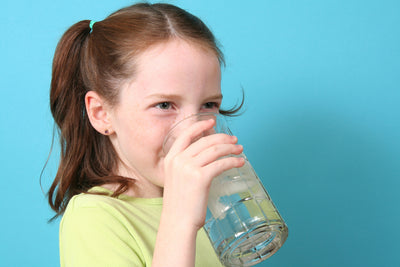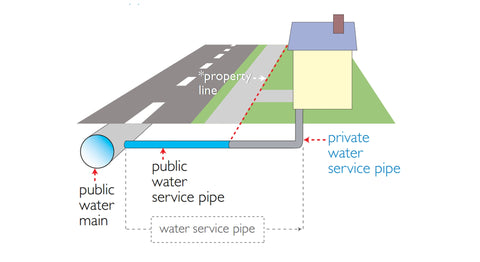How Does Lead Enter Drinking Water?
RSS
How Does Lead Enter Municipal Tap Water?
Lead contaminates tap water differently than most pollutants, because lead comes from plumbing, not the water supply. For example, some buildings in older neighborhoods have lead-containing service pipes that connect water mains to the residential plumbing (see image below), and plumbing installed before 1986 often used lead-containing solder to join copper pipes. If corrosion control measures fail (what happened in Flint, MI), lead can leach from the pipes into the tap water. This problem is compounded when water sits stagnant for several hours before use (e.g. overnight or while resident is at work), because lead concentrations rise as corrosive water remains sitting in the pipes.
Diagram Showing Underground Components of Residential Plumbing
EPA Lead Pipe Survey
A recently released EPA nationwide survey of water infrastructure revealed that 9.2 million lead pipes carry water into homes across the U.S. This survey was the first time lead pipes were being counted. Florida had the highest number of lead water pipes in the nation with an estimated 1.16 million pipes or 12.6% of the total. Illinois had the second highest number of lead pipes in the nation, with an estimated 1.04 million pipes, or 11.6 % of the total. The states with the next highest number of lead pipes were Ohio (8.11%), Pennsylvania (7.5%), Texas (7.05%), and New York (5.38%). EPA hopes to use this survey to prioritize the states that need more funding for improvements, which include identifying and removing lead pipes.
Is Well Water Susceptible To Lead Contamination?
Most people are surprised to learn that groundwater can often be more corrosive than surface water. The USGS created a comprehensive report highlighting areas of the country with highly corrosive groundwater, which can be found here. Corrosive water can become problematic if it dissolves lead from pipes, causing lead to leach into drinking water (this is a similar situation to what happened in Flint, Michigan). At the municipal level, if a utility provider switches its disinfectant from chlorine to chloramine, they'll need to add a corrosion inhibitor to reduce water corrosivity. If you're a private well user, you might not realize that your water is corrosive until it's too late. There are anthropogenic activities that can make both surface and groundwater more corrosive. One example is the use of road salts to treat icy roads. Runoff containing road salts can enter rivers, other surface water sources, and infiltrate into underground aquifers.
How Does EPA Regulate Lead In Drinking Water?
The Lead and Copper Rule was originally established by EPA in 1991 to protect the public from toxic levels of lead and copper that leach from pipes. Because the route of contamination is unique, The Lead and Copper Rule is fundamentally different from other drinking water regulations in two main ways:
Sampling Methodology: Most water quality tests are performed on samples collected from locations under direct control of the municipality (water mains, service access points), while samples collected as part of The Lead and Copper Rule come from the resident’s tap. By sampling at the tap, water flows through the underground service line and residential plumbing, and can pick up lead along the way if it's present. Furthermore, the Lead and Copper Rule requires that samples are collected after the water has been sitting stagnant in the pipes for at least 6 hours, which gives time for lead to accumulate in the pipes. This sampling method recreates common water usage scenarios (when residents are sleeping and/or at work), and attempts to hold municipalities responsible for providing water that doesn't draw lead from pipes. This is a very good thing, because many people (particularly renters) don’t know a lot about their building’s plumbing or underground pipes.
Violation Criteria: For most pollutants, EPA establishes a risk-based Maximum Contaminant Level (MCL), and a violation is triggered if the concentration of the pollutant exceeds the MCL. EPA has not set an MCL for lead, though it has set a Maximum Contaminant Level Goal (MCLG) of 0 ppb. Unlike the MCL, the MCLG is a non-enforceable public health target where there is no known or expected risk to human health. EPA uses a different set of criteria when determining violations under the Lead and Copper Rule. Instead of using risk-based MCL thresholds, EPA uses a different term (Action Level) for the threshold, which is 15 parts per billion for lead. It's important to point out that EPA acknowledges that there is no safe level for lead... so the 15 ppb threshold is somewhat arbitrary. Using the Action Level threshold methodology, a municipality is in violation of the Lead and Copper Rule only if 10% or more of the samples have more than 15 ppb lead present. To restate that in a slightly different way: up to 10% of the samples can have lead concentrations higher than 15 ppb and still be in compliance, even if some samples have extremely high lead levels.
Shortcomings Of The Lead And Copper Rule: While the Lead and Copper Rule does a good thing by requiring samples to be collected at the tap, the rule has large "blind spots" when it comes to sampling practices. For example, the rule does not require municipalities to collect large numbers of samples to be tested for lead, or even require that samples be collected each year. This holds true, even for large cities like Atlanta, which last collected samples for lead analysis in 2012, and at that time it only collected and analyzed 51 samples citywide. Other large cities, such as Dallas and Houston did not disclose the number of samples that were collected and subsequently tested for lead. The Lead and Copper Rule is a system that is designed to detect system-wide process upsets, not to detect contamination events on short-term time scales.
Case Study: NYC Drinking Water
New York City is widely recognized in the water industry as the “Gold Standard” for urban tap water.
The source water is well-protected, the pipelines used to transport the water from the source are impressive feats of engineering, and the city spends a lot of money on municipal infrastructure. However, in the case of lead, these things don't matter if lead is able to leach from residential plumbing.This is particularly important in New York City for two main reasons:
- There are a lot of older buildings in New York City, which are most likely to have lead-containing service pipes and residential plumbing
- A large proportion of New York City residents are renters, and have little or no information about the age/composition of their building’s plumbing
(EPA Action Level = 15 ppb)

This table shows compiled data (aggregated from city reports) for NYC drinking water samples collected from customers’ faucets during the years 2007 through 2022. In all years, a meaningful percentage of the samples tested for lead were above the 15 ppb threshold set by US EPA, with some samples being recorded at upwards of 400 times that. It’s important to point out that despite the high lead levels, 2010 was the only year where NYC was in violation of EPA’s Lead and Copper Rule, because it was the only year where more than 10% of samples exceeded the 15 ppb threshold. According to the most recent report which includes the data for 2022, the 90th percentile was 11ppb. While the lead levels in NYC water seen in the other years are in compliance with federal regulations, the EPA, CDC, and the American Academy of Pediatrics all agree that there is no safe amount of lead for children.
To minimize lead exposure from drinking water, New York City (as well as other municipalities) recommends that you allow your water to run for 2 minutes (or longer if you live in a large building) before collecting water for consumption. Doing so allows the stagnant water that is in residential pipes to flush and be refilled with fresh water coming off the main.
Sources:
7th Drinking Water Infrastructure Needs Survey and Assessment
https://www.epa.gov/dwreginfo/lead-and-copper-rule
https://www1.nyc.gov/site/dep/about/drinking-water-supply-quality-report.page
https://www.dcwater.com/sites/default/files/household_water_quality.pdf





